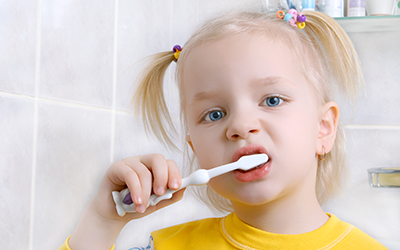Posted on Jul 14, 2025
File ID 2005478 | © Radkevich Siarhei | Dreamstime.com
 New Patient Forms
New Patient Forms 
Tooth development is one of the most significant milestones in a child’s early years. From the first tooth eruption to the formation of healthy oral habits, understanding how teeth grow in infants and toddlers sets the foundation for lifelong dental wellness. Whether you’re searching for orthodontics near me or planning your child’s first dental visit, learning these basics can help you make informed decisions.
Tooth formation actually begins before birth. Primary teeth, also called baby teeth, start developing in the fetus around the sixth week of pregnancy. However, they typically begin to appear in the mouth between 4 and 10 months of age.
Here’s a general timeline of tooth eruption in infants:
· 6–10 months: Lower central incisors
· 8–12 months: Upper central incisors
· 9–16 months: Lateral incisors
· 13–19 months: First molars
· 16–23 months: Canines
· 23–33 months: Second molars
By age 3, most children have a complete set of 20 primary teeth. These baby teeth play an essential role in helping children speak clearly, chew effectively, and guide the proper spacing for their permanent teeth. Many parents begin searching for a near me orthodontist around this age for preventive evaluations.
Teething can be an uncomfortable process for babies and their caregivers alike.
Common signs of teething include:
· Excessive drooling
· Chewing on toys or fingers
· Irritability or fussiness
· Swollen or tender gums
· Interrupted sleep patterns
Safe remedies for soothing teething discomfort include chilled (not frozen) teething rings, a clean cold washcloth to chew on, or gentle gum massages. While teething is a normal developmental phase, persistent symptoms such as high fever or rash may warrant a consultation with a pediatrician.
Even before the first tooth appears, oral care matters. Wiping your baby’s gums with a clean, damp cloth helps prevent bacteria buildup. Once teeth erupt, use a soft-bristled baby toothbrush and a smear of fluoride toothpaste to clean them twice a day.
The American Dental Association recommends scheduling your child’s first dental visit by their first birthday or within six months of their first tooth appearing. During this visit, your provider will assess overall oral health, offer hygiene guidance, and identify any early concerns, such as signs of baby bottle tooth decay.
Several behaviors during infancy and toddlerhood can affect long-term oral development:
· Thumb sucking: Normal for infants, but prolonged habits beyond age 3 can alter bite alignment.
· Pacifier use: Extended use may lead to open bite or speech issues.
· Tongue thrusting: This swallowing pattern can push front teeth out of alignment.
These habits are among the reasons parents begin exploring care from an orthodontist near me when children are still quite young. An early consultation helps determine whether any developing patterns could benefit from monitoring or gentle correction.
Though braces aren’t usually placed until the teen years, early screenings can identify issues like crowding, jaw irregularities, or delayed tooth eruption. Ohmart Orthodontics often recommends an initial evaluation around age 7 to determine whether your child’s bite is developing normally. This approach, called interceptive orthodontics, may reduce the need for more extensive treatment later.
If you’ve been searching for orthodontics near me, it’s important to choose a provider experienced with pediatric cases and early intervention strategies. Ohmart Orthodontics offers personalized care for every age, from young children to adults.
Promoting good oral habits early on sets your child up for success.
Here’s how you can help:
1. Brush twice daily with a fluoride toothpaste (use a pea-sized amount for toddlers).
2. Avoid sugary drinks and snacks between meals.
3. Schedule regular dental checkups starting by age one.
4. Wean off pacifiers and thumb-sucking by age 3.
5. Monitor for early bite problems and consult a near me orthodontist if concerns arise.
For more information about pediatric and family orthodontics, visit Ohmart Orthodontics’ website, where you can explore treatment options tailored to every stage of dental development.
Tooth development in infants and toddlers is more than just a series of teething milestones—it’s the beginning of a healthy, confident smile. With early care, routine evaluations, and support from a skilled orthodontist near me, you can ensure your child’s smile grows strong for life.